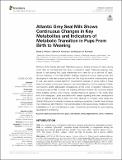Files in this item
Atlantic grey seal milk shows continuous changes in key metabolites and indicators of metabolic transition in pups from birth to weaning
Item metadata
| dc.contributor.author | Watson, David | |
| dc.contributor.author | Pomeroy, Patrick | |
| dc.contributor.author | Kennedy, Malcolm | |
| dc.date.accessioned | 2021-01-11T10:30:03Z | |
| dc.date.available | 2021-01-11T10:30:03Z | |
| dc.date.issued | 2021-01-11 | |
| dc.identifier | 269567460 | |
| dc.identifier | 28904143-263a-49a6-a64c-2124880d099e | |
| dc.identifier | 85099872134 | |
| dc.identifier | 000611878500001 | |
| dc.identifier.citation | Watson , D , Pomeroy , P & Kennedy , M 2021 , ' Atlantic grey seal milk shows continuous changes in key metabolites and indicators of metabolic transition in pups from birth to weaning ' , Frontiers in Marine Science , vol. 7 , 596904 . https://doi.org/10.3389/fmars.2020.596904 | en |
| dc.identifier.issn | 2296-7745 | |
| dc.identifier.other | ORCID: /0000-0003-1603-5630/work/86986532 | |
| dc.identifier.uri | https://hdl.handle.net/10023/21255 | |
| dc.description | The work was funded from core support given to the Sea Mammal Research Unit, Scottish Oceans Institute, from the National Environmental Research Council (United Kingdom), and separately by the Universities of Glasgow and Strathclyde. The funding of mass spectrometry equipment for metabolomics was provided by the Scottish Life Sciences Alliance. | en |
| dc.description.abstract | Mothers of the Atlantic grey seal, Halichoerus grypus, lactate for about 20 days, during which they do not feed and may have no access to water. Following weaning, they depart to sea leaving their pups unattended and unfed for up to another 40 days. We are interested in how this lactation strategy supports the pups’ rapid growth and development while also preparing them for their long fast before independently going to sea. We report a broad spectrum metabolomic analysis of whole milks of these seals that reveals continuous changes in key metabolites from birth to weaning. Certain components exhibit abbreviated appearances at the onset of lactation, followed by continuous rises or falls in others until weaning. Riboflavin/Vitamin B2, hormone-related sterol sulfates, lactose, and complex oligosaccharides all appear in milk briefly after birth then disappear. Lipids associated with cellular signaling and brain development occur at highest levels shortly after birth, then diminish. In contrast, other lipids and Vitamin B6/pyridoxine steadily increase as weaning approaches. Overall, these findings may indicate an early transition from carbohydrate to fat-based energy metabolism and establishment of gut microbiomes in pups, followed by provisioning for post-weaning development and fasting. | |
| dc.format.extent | 13 | |
| dc.format.extent | 2428000 | |
| dc.language.iso | eng | |
| dc.relation.ispartof | Frontiers in Marine Science | en |
| dc.subject | Atlantic grey seal | en |
| dc.subject | Halichoerus grypus | en |
| dc.subject | Milk | en |
| dc.subject | Vitamins | en |
| dc.subject | Lactose | en |
| dc.subject | Oligosaccharides | en |
| dc.subject | Sterols | en |
| dc.subject | Metabolome | en |
| dc.subject | QH301 Biology | en |
| dc.subject | DAS | en |
| dc.subject.lcc | QH301 | en |
| dc.title | Atlantic grey seal milk shows continuous changes in key metabolites and indicators of metabolic transition in pups from birth to weaning | en |
| dc.type | Journal article | en |
| dc.contributor.institution | University of St Andrews. School of Biology | en |
| dc.contributor.institution | University of St Andrews. Sea Mammal Research Unit | en |
| dc.contributor.institution | University of St Andrews. Scottish Oceans Institute | en |
| dc.contributor.institution | University of St Andrews. Centre for Research into Ecological & Environmental Modelling | en |
| dc.contributor.institution | University of St Andrews. Marine Alliance for Science & Technology Scotland | en |
| dc.identifier.doi | https://doi.org/10.3389/fmars.2020.596904 | |
| dc.description.status | Peer reviewed | en |
| dc.identifier.url | https://www.frontiersin.org/articles/10.3389/fmars.2020.596904/full | en |
This item appears in the following Collection(s)
Items in the St Andrews Research Repository are protected by copyright, with all rights reserved, unless otherwise indicated.

